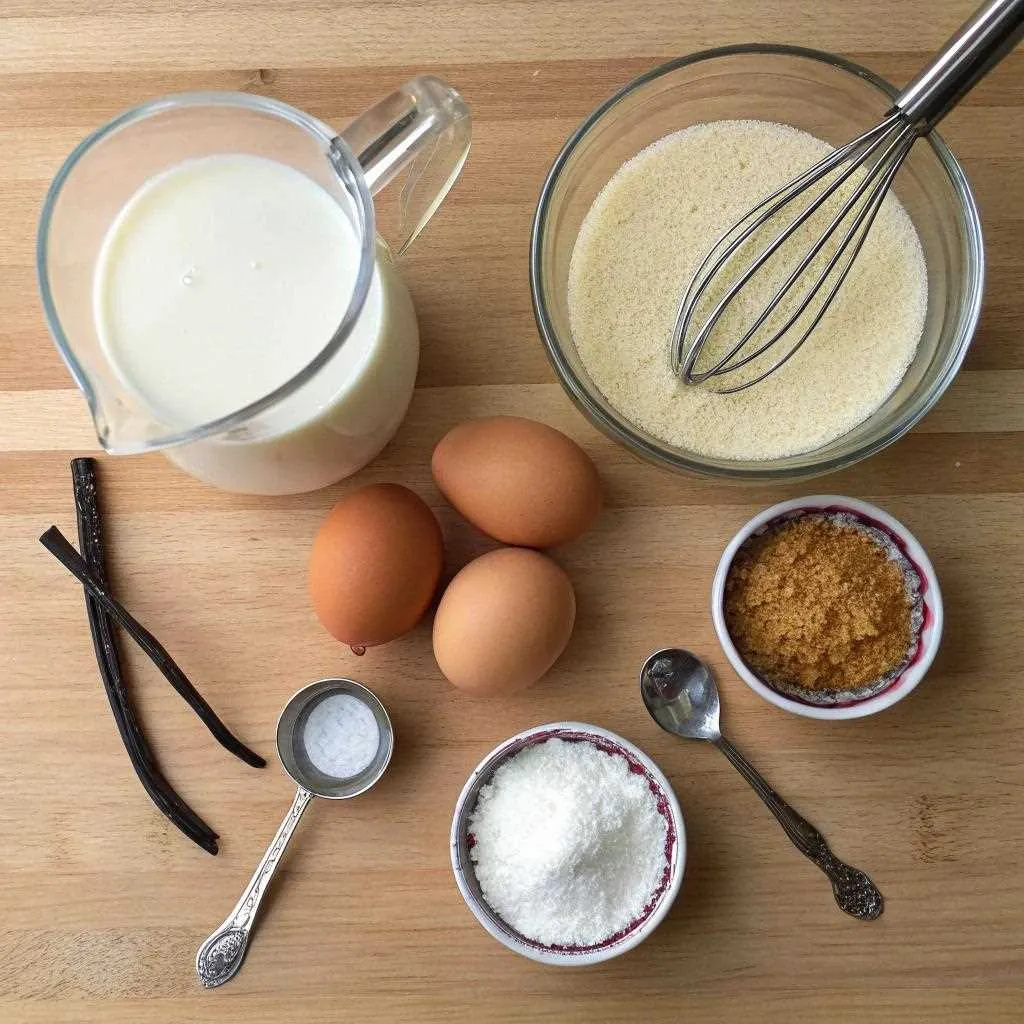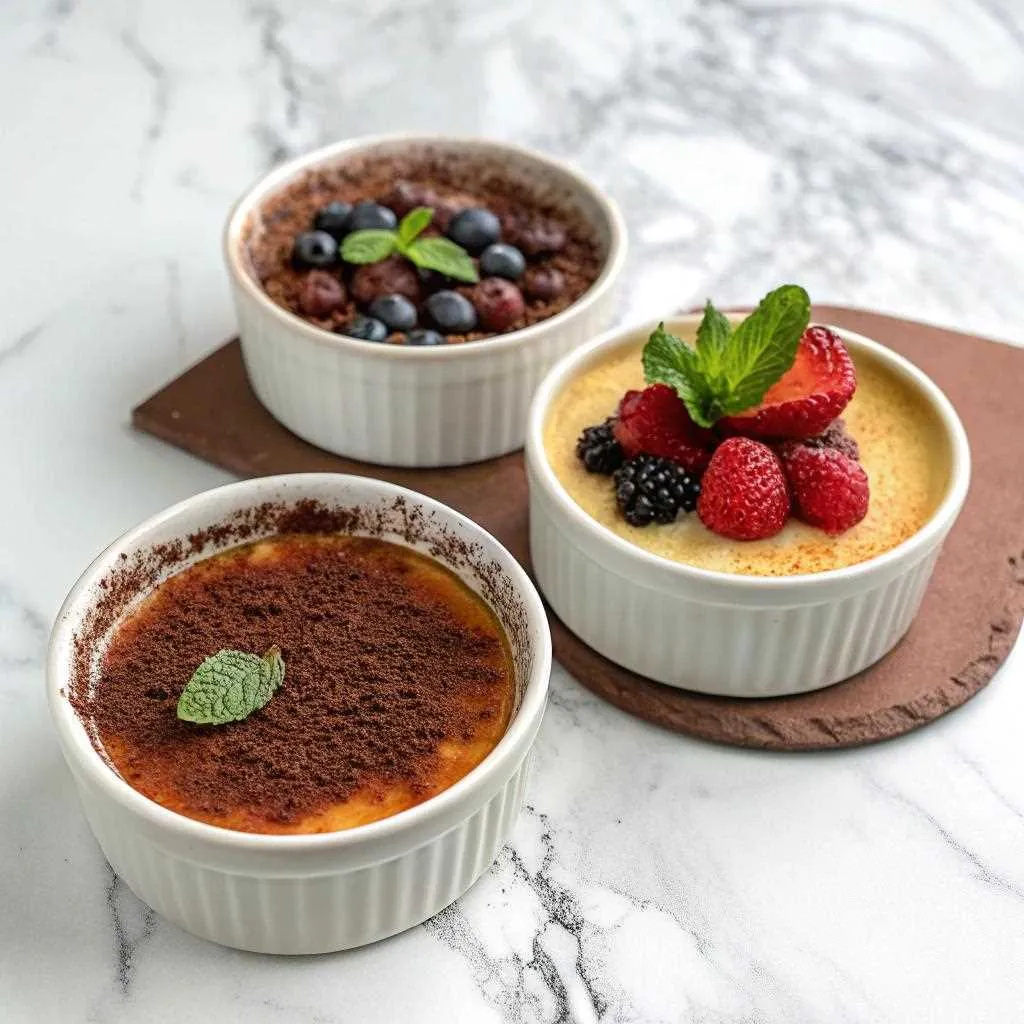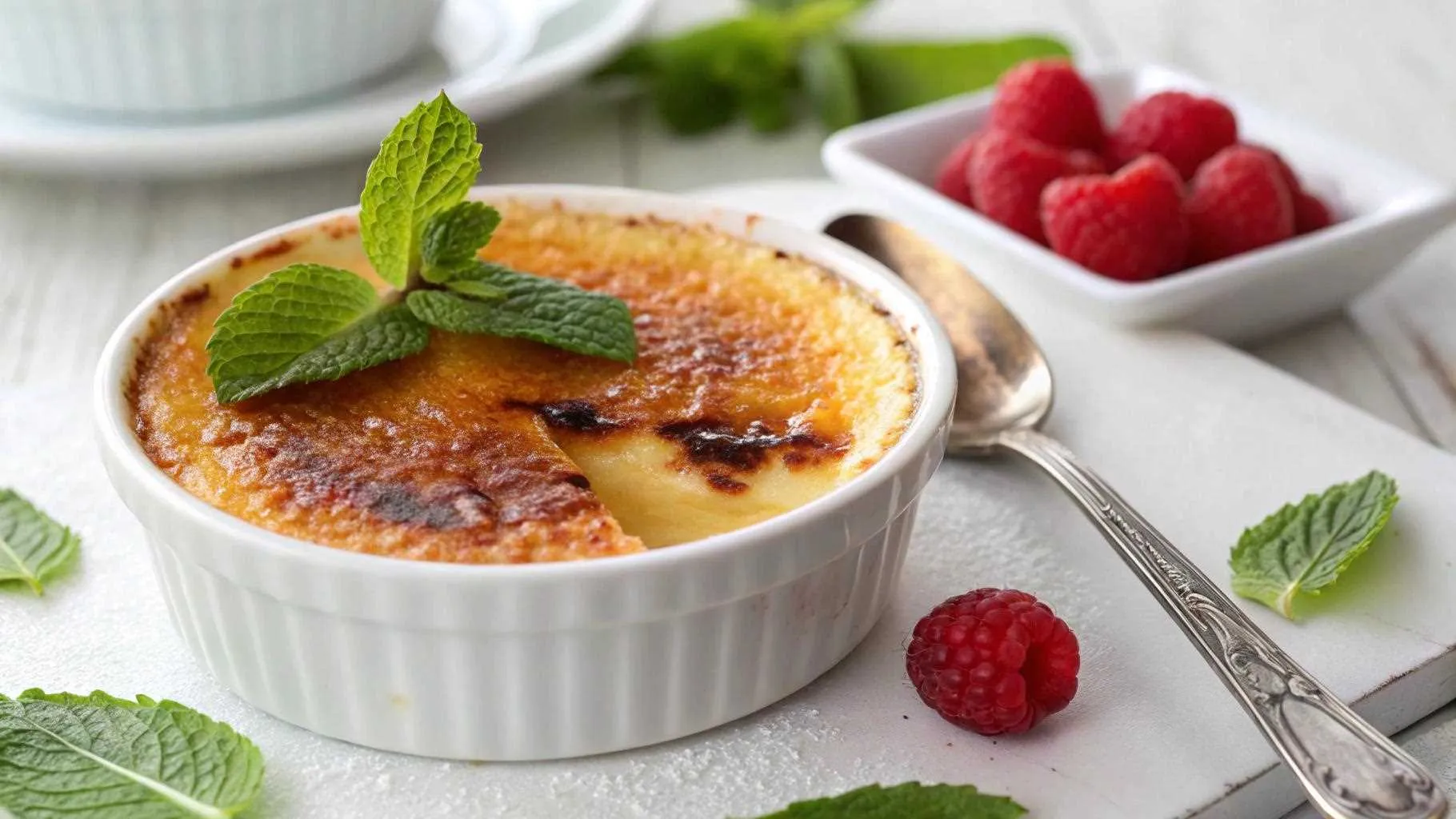Table of Contents
Introduction
Crème Brûlée is the epitome of elegance when it comes to desserts. Its silky-smooth custard paired with a crisp caramelized sugar topping is enough to wow anyone at the dinner table. But what if you could create this luxurious dessert using milk instead of heavy cream? Not only does this make the recipe lighter, but it also keeps it just as rich and flavorful. Whether you’re a seasoned baker or new to creating desserts, this recipe is simple, delicious, and perfect for any occasion. Dive in to learn all the secrets to making the best crème brûlée recipe with milk
What Is Crème Brûlée?
History of Crème Brûlée
Crème brûlée, translating to “burnt cream” in French, is a timeless dessert with a history as rich as its flavor. It first appeared in French cookbooks in the 17th century but has counterparts in Spanish (Crema Catalana) and English cuisine (Trinity Cream). Traditionally made with cream, sugar, and egg yolks, it’s celebrated for its contrast of creamy custard and crunchy caramelized sugar.
Traditional vs. Modern Variations
While the original recipe uses heavy cream for its rich texture, modern variations have adapted to dietary preferences and ingredient availability. This recipe replaces heavy cream with milk, yielding a dessert that’s just as indulgent but lighter on the palate. You’ll still achieve that luscious, velvety custard, just without the added heaviness.
Why Use Milk in Crème Brûlée?
Using milk offers multiple benefits:
- Lighter Texture: Ideal for those who find traditional crème brûlée too rich.
- Accessibility: Milk is often more readily available than cream.
- Flavor Pairing: Milk allows the flavors of vanilla or other infusions to shine more brightly.
This adaptation is perfect for anyone looking for a lighter yet decadent dessert option.
Ingredients for the Best Crème Brûlée Recipe with Milk
Creating the best crème brûlée with milk starts with selecting the right ingredients. This simplified yet luxurious dessert relies on fresh, high-quality items to achieve its signature creamy texture and caramelized top.
Simple Ingredient List

Here’s what you’ll need to make a perfect milk-based crème brûlée:
- 2 cups of whole milk: Provides creaminess while keeping the dessert lighter.
- 5 large egg yolks: The foundation for the custard’s velvety texture.
- ½ cup granulated sugar: Adds sweetness and helps create the caramelized topping.
- 1 teaspoon pure vanilla extract or a vanilla bean: For that authentic, aromatic flavor.
- Pinch of salt: Enhances the overall taste.
- Extra sugar for caramelizing: Usually 2-3 tablespoons.
Substitutions and Alternatives
- Plant-Based Milk: Almond milk or oat milk can be used for a dairy-free version, but it may slightly alter the texture.
- Brown Sugar: Swap granulated sugar for brown sugar to give the custard a deeper, molasses-like flavor.
- Flavor Additions: Infuse the milk with orange zest, cinnamon sticks, or coffee for a unique twist.
Tips for Choosing Quality Ingredients
- Eggs: Use fresh, high-quality eggs for a smoother custard.
- Milk: Whole milk works best, but if you prefer a creamier result, add a splash of half-and-half.
- Vanilla: A real vanilla bean adds a luxurious flavor and a visual touch with its tiny black specks.
Step-by-Step Instructions for Making Crème Brûlée with Milk
Creating the perfect crème brûlée with milk might seem daunting, but with these clear steps, you’ll have a silky custard and a crackling caramel top in no time.
1. Gather Your Tools and Preheat the Oven
Before starting, assemble the necessary tools:
- Mixing bowls
- Whisk
- Saucepan
- Ramekins (4-6, depending on size)
- Baking dish
- Kitchen torch (optional)
Preheat your oven to 325°F (160°C). This low temperature ensures the custard bakes evenly without curdling.
2. Heat the Milk
In a saucepan, gently warm 2 cups of whole milk over medium heat. Add a vanilla bean (split and seeds scraped) or 1 teaspoon of vanilla extract. Heat until it’s warm but not boiling—about 170°F (77°C). Remove from heat and let it cool slightly.
3. Whisk the Egg Yolks and Sugar
In a mixing bowl, whisk together:
- 5 large egg yolks
- ½ cup granulated sugar
Whisk until the mixture turns pale yellow and creamy, ensuring the sugar is fully dissolved.
4. Combine the Milk and Egg Mixture
Slowly pour the warm milk into the egg mixture while whisking constantly. This step, called tempering, prevents the eggs from scrambling. Strain the mixture through a fine sieve to remove any cooked egg bits for a smooth custard.
5. Pour into Ramekins
Place your ramekins in a deep baking dish. Evenly distribute the custard mixture into the ramekins, filling them about ¾ full.
6. Prepare the Water Bath
Fill the baking dish with hot water until it reaches halfway up the sides of the ramekins. The water bath ensures gentle, even cooking and prevents the custard from cracking.
7. Bake to Perfection
Carefully transfer the baking dish to the preheated oven. Bake for 35-45 minutes, or until the edges are set but the center jiggles slightly when shaken. Avoid overbaking, as it can lead to a grainy texture.
8. Chill the Custards
Once baked, remove the ramekins from the water bath and let them cool to room temperature. Cover them with plastic wrap and refrigerate for at least 4 hours or overnight for the best results.
9. Caramelize the Sugar
Before serving, sprinkle 1-2 teaspoons of granulated sugar evenly over each custard. Use a kitchen torch to caramelize the sugar until it turns golden and forms a crisp layer. If you don’t have a torch, place the ramekins under the oven broiler for 2-3 minutes, watching closely to prevent burning.
10. Serve and Enjoy
Let the caramelized tops cool for a minute before serving. Tap the surface with a spoon to crack the sugar and reveal the creamy custard beneath.
How to Choose the Right Milk for Crème Brûlée
The type of milk you use plays a crucial role in determining the texture and flavor of your crème brûlée. While heavy cream is traditionally used, milk can create a lighter and equally delicious version. Here’s a guide to help you choose the perfect milk for this recipe.
Whole Milk vs. Skim Milk
- Whole Milk: This is the ideal choice for crème brûlée with milk. Its higher fat content (around 3.5%) ensures a creamy texture that’s similar to using cream, but without the heaviness.
- Skim Milk: While you can use skim milk, it lacks the richness of whole milk and may result in a thinner custard. Consider blending skim milk with a splash of half-and-half to improve the texture.
Can You Use Plant-Based Milk?
Plant-based milks are excellent for those seeking dairy-free alternatives. However, they require careful selection:
- Almond Milk: Adds a subtle nutty flavor but may yield a slightly looser texture.
- Oat Milk: Creamier than most plant-based milks and closest to whole milk in texture.
- Coconut Milk: Rich and flavorful but adds a distinct coconut taste, which may overpower the dessert’s classic vanilla flavor.
Enhancing Flavor with Milk Additions
- Infusions: Before warming the milk, add ingredients like cinnamon sticks, orange zest, or lavender for a unique twist.
- Vanilla: Whether you use vanilla extract, paste, or a whole vanilla bean, it’s essential for the dessert’s signature flavor.
Choosing the right milk allows you to customize the recipe to your dietary needs and flavor preferences, ensuring a delicious result every time.
Common Mistakes to Avoid
Making crème brûlée with milk is straightforward, but a few common mistakes can lead to disappointing results. By avoiding these pitfalls, you’ll ensure your dessert turns out perfectly every time.
1. Overcooking the Custard
One of the most frequent issues is overbaking.
- What Happens: Overcooking leads to a grainy or rubbery custard texture.
- How to Avoid: Bake until the edges are set, but the center jiggles slightly when shaken. Use a thermometer; the ideal internal temperature is around 170–175°F (77–80°C).
2. Skipping the Water Bath
The water bath (or bain-marie) is essential for even cooking.
- What Happens: Without it, the custard can cook unevenly or develop cracks on the surface.
- How to Avoid: Always place your ramekins in a baking dish filled with hot water, ensuring it reaches halfway up the sides of the ramekins.
3. Failing to Temper the Eggs Properly
When combining warm milk with the egg yolks, tempering is crucial.
- What Happens: Pouring hot milk too quickly can scramble the eggs.
- How to Avoid: Gradually pour the milk into the egg mixture while whisking constantly. Strain the mixture afterward to remove any curdled bits.
4. Inconsistent Caramelization of Sugar
Achieving that perfect sugar crust requires the right technique.
- What Happens: Uneven sugar coverage or burning can ruin the presentation and taste.
- How to Avoid: Spread the sugar evenly over the custard and use a torch for better control. If using a broiler, watch closely to prevent burning.
5. Using Low-Quality Ingredients
Every ingredient impacts the final result.
- What Happens: Subpar eggs, milk, or vanilla can make the dessert taste bland.
- How to Avoid: Choose fresh, high-quality ingredients for the best flavor and texture.
Variations of Crème Brûlée with Milk

Crème brûlée is a versatile dessert that can be customized to suit your flavor preferences or dietary needs. By tweaking a few ingredients, you can create exciting variations that go beyond the classic recipe.
1. Chocolate Crème Brûlée
Adding chocolate to your custard creates a rich and decadent twist.
- How to Make It: Melt ½ cup of dark chocolate into the warm milk before combining it with the egg mixture.
- Perfect Pairings: Top with a light dusting of cocoa powder or shaved chocolate for a stunning presentation.
2. Fruit-Infused Crème Brûlée
Fruity flavors add a refreshing dimension to the dessert.
- Options:
- Orange or Lemon: Infuse the milk with zest for a citrusy punch.
- Berry Compote: Swirl a small spoonful of raspberry or blueberry puree into the custard before baking.
- Finishing Touch: Garnish with fresh fruit for an extra burst of color and flavor.
3. Alcohol-Infused Crème Brûlée
A splash of your favorite liqueur can elevate the dessert’s sophistication.
- Popular Choices:
- Baileys Irish Cream: Adds a creamy, boozy flavor.
- Grand Marnier: Offers a subtle orange liqueur essence.
- Rum or Brandy: For a warm, spiced undertone.
- Tip: Add 1–2 tablespoons of liqueur to the warm milk.
4. Dairy-Free or Vegan Crème Brûlée
For those avoiding dairy, plant-based options can still deliver a creamy texture.
- How to Make It: Use oat milk or coconut milk as the base. Replace eggs with cornstarch or agar-agar to set the custard.
These creative twists allow you to explore new flavors while retaining the elegance of the classic dessert.
Serving and Storing Crème Brûlée
Serving crème brûlée is as much about presentation as it is about taste. Proper storage ensures your dessert stays fresh and ready to impress at any moment. Here’s how to make the most of your masterpiece.
Best Ways to Serve Crème Brûlée
- Chilled Perfection
- Crème brûlée is best served cold with a freshly caramelized top.
- The contrast between the cold, creamy custard and the warm, crackling sugar layer is what makes this dessert irresistible.
- Toppings and Garnishes
- While the classic caramelized sugar crust is enough, you can enhance the presentation with:
- Fresh berries like raspberries or strawberries.
- A sprig of mint for a touch of elegance.
- A light dusting of powdered sugar for added flair.
- While the classic caramelized sugar crust is enough, you can enhance the presentation with:
- Pairing Ideas
- Serve alongside a cup of espresso, a glass of dessert wine, or a light sparkling champagne for a truly luxurious experience.
Storing Crème Brûlée for Freshness
- Refrigeration
- After the custard has set, cover each ramekin tightly with plastic wrap or foil to prevent them from absorbing fridge odors.
- Crème brûlée can be stored for up to 3 days in the refrigerator.
- Freezing Option
- While not ideal, the custard can be frozen before caramelizing. Thaw it in the refrigerator overnight and caramelize the sugar topping just before serving.
Reheating and Caramelizing
- Do not reheat the custard itself, as it will lose its creamy texture.
- Caramelize the sugar topping fresh before serving, either with a torch or under the broiler for 2-3 minutes.
Health Benefits of Milk-Based Crème Brûlée
Using milk instead of heavy cream in crème brûlée not only lightens the dessert but also offers some surprising health benefits. While this classic treat is still indulgent, milk-based variations can be a more balanced choice for those looking to enjoy it guilt-free.
1. Lower Fat Content
- Milk vs. Heavy Cream: Whole milk has significantly less fat than heavy cream, reducing the overall calorie count of the dessert.
- Benefit: This makes the recipe suitable for those watching their fat intake without sacrificing the creamy texture and rich flavor.
2. High Nutritional Value
- Rich in Nutrients: Milk is a great source of calcium, vitamin D, and potassium, which support bone health and overall well-being.
- Protein Content: Each serving provides a good dose of protein, making it a satisfying treat that can help curb sugar cravings.
3. Lighter Digestion
- The lower fat content makes milk-based crème brûlée easier to digest for some people, especially compared to the richness of traditional heavy cream versions.
- Opting for lactose-free milk or plant-based alternatives can also make it suitable for those with lactose intolerance.
4. Portion Control
- Crème brûlée is served in individual portions, helping to naturally control serving sizes and reduce the risk of overindulging.
By swapping heavy cream for milk, you can enjoy the same indulgent flavors while reaping some additional benefits. This lighter version is perfect for a more health-conscious approach to dessert.
FAQs About Crème Brûlée with Milk
Crème brûlée is a beloved dessert, but making it with milk can raise a few questions. Here are answers to the most common queries to help you master this recipe.
1. Can I use milk instead of cream in crème brûlée?
Yes, you can! Milk is a fantastic substitute for cream, creating a lighter version of crème brûlée without sacrificing flavor or texture. Whole milk works best as it maintains a creamy consistency. If you prefer an even richer texture, consider blending milk with a small amount of half-and-half.
2. Does crème brûlée have milk in it?
Traditionally, crème brûlée is made with heavy cream, but milk can be used as a substitute. Recipes with milk are a modern twist, providing a less rich yet equally satisfying custard. The dessert’s essence—eggs, sugar, and vanilla—remains the same, regardless of whether you use cream or milk.
3. What is the secret to crème brûlée?
The secret lies in achieving the perfect balance of creamy custard and a crisp, caramelized sugar topping. Key tips include:
- Tempering the eggs to avoid curdling.
- Using a water bath for even baking.
- Caramelizing the sugar evenly for a satisfying crunch.
4. Why do you need to scald milk for crème brûlée?
Scalding milk (heating it until just below boiling) is essential for two reasons:
- It helps dissolve the sugar and infuse flavors, such as vanilla or citrus zest, into the custard.
- It aids in tempering the eggs gently, ensuring a smooth, lump-free custard.
5. What is the difference between crème brûlée and burnt cream?
The terms are often used interchangeably, but historically, crème brûlée refers to the French version, while “burnt cream” is the English counterpart. Both feature a caramelized sugar topping, but the methods and flavor nuances may differ slightly depending on regional preferences.
6. What is the difference between scalded milk and boiled milk?
- Scalded Milk: Heated to just below boiling, around 180°F (82°C). It’s used to enhance flavor and blend smoothly with other ingredients.
- Boiled Milk: Heated to its boiling point (212°F/100°C), often causing a skin to form on top. Overheating milk can change its flavor and consistency, making scalding the better choice for recipes like crème brûlée.
Conclusion and Final Tips
Crème brûlée is the kind of dessert that never fails to impress. By substituting milk for heavy cream, you can create a lighter version of this classic treat while preserving its luxurious flavor and texture. Whether you’re serving it at a fancy dinner party or indulging in a quiet evening treat, this recipe ensures success every time.
“If you’re exploring more recipes, don’t miss this guide to Dave’s killer bread maker recipes for another culinary adventure.”
Final Tips for the Best Crème Brûlée with Milk
- Use Whole Milk: For the creamiest results, opt for whole milk. If you’re feeling adventurous, try plant-based options like oat milk for a unique twist.
- Don’t Skip the Water Bath: It may seem like an extra step, but a water bath is essential to achieve a smooth, evenly cooked custard.
- Caramelize Carefully: Use a kitchen torch for precision and a beautifully golden sugar crust. If using a broiler, keep a close eye to prevent burning.
- Infuse Flavor: Experiment with flavors like orange zest, lavender, or coffee to add an exciting touch to your custard.
As you dig your spoon into the crisp caramelized sugar and scoop up the creamy custard, you’ll see why crème brûlée is a timeless favorite. Whether you stick to the classic vanilla or explore creative variations, this milk-based recipe is your go-to guide for delicious results.
Ready to create your own stunning crème brûlée? Don’t wait—grab your ramekins and torch, and bring this dessert to life!


1 thought on “The Best Crème Brûlée Recipe Made with Milk – Simple & Delicious”